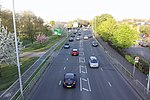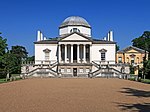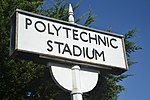Staveley Road
1944 in London1944 in military historyBuildings and structures in the London Borough of HounslowBuildings and structures in the United Kingdom destroyed during World War IIChiswick ... and 6 more
Explosions in LondonHistory of the London Borough of HounslowMonuments and memorials in LondonStreets in the London Borough of HounslowUse British English from July 2017V-weapons

Staveley Road is a road in Chiswick in the London Borough of Hounslow which was the site of the first successful V-2 missile attack against Britain.
Excerpt from the Wikipedia article Staveley Road (License: CC BY-SA 3.0, Authors, Images).Staveley Road
Staveley Road, London Grove Park (London Borough of Hounslow)
Geographical coordinates (GPS) Address Nearby Places Show on map
Geographical coordinates (GPS)
| Latitude | Longitude |
|---|---|
| N 51.4828 ° | E -0.265 ° |
Address
Staveley Road
Staveley Road
W4 3ES London, Grove Park (London Borough of Hounslow)
England, United Kingdom
Open on Google Maps







